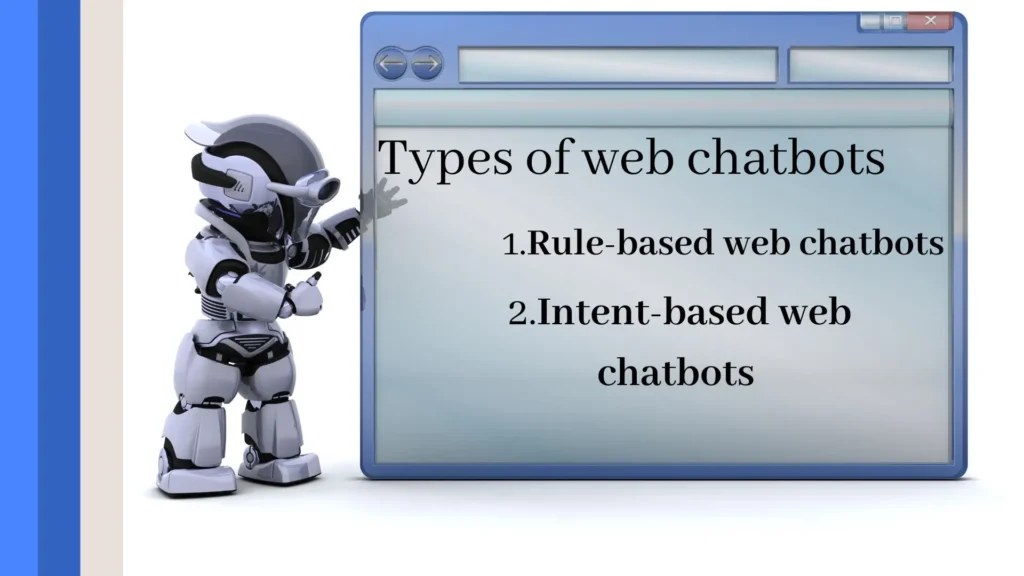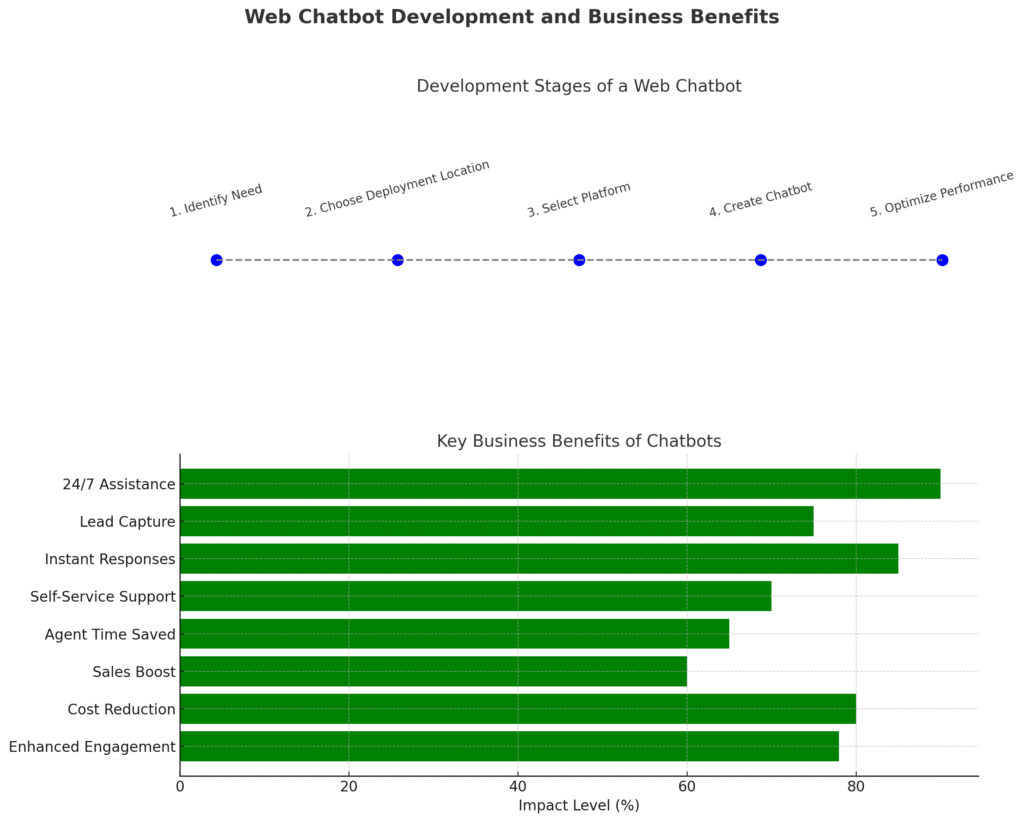The sophistication level of chatbots, together with their usefulness, has experienced substantial improvements during the past several years. The original experimental tool evolved into an essential business system that helps companies gain customers while delivering better services at reduced costs to larger audiences. Anyone can now make and release chatbots through no-code artificial intelligence tools, which eliminates the requirement for a developer.
Many users start their information search with a chatbot on a website before they explore either the pages or employ the search bar. Designers of chatbots need to present a customer-centric approach to intent-focused processes to achieve streamlined simplicity in their platforms.
Types of web chatbots

Rule-based web chatbots
The decision-tree structure in these chatbots leads people to their answers through selected options. Traditional phone systems serve as a model to understand these digital bots since callers use number-based prompts to reach their desired service area.
Implementing rule-based chatbots provides quick deployment for answering common queries that website visitors along phone customers previously sought through self-service or agent assistance. Through straightforward dialogue menus within chat windows, customers can receive responses for all queries, including store operations and product inventory data, along with account information.
Intent-based web chatbots
These bots operate under the name conversational bots because they seek to establish conversational interactions with users. These virtual assistants become highly effective when someone lacks precise clarity about their objectives. People utilizing web chatbots seek solutions rather than particular services like account balance inquiries or purchasing information, since they need assistance with their unresolved problems.
People obtain better solutions from the chatbot because it understands their intended request through its recognition system. Complete achievement of a functional chatbot depends on detailed plans for each stage that align with its values and personality, scope, and goals.
The training process that designers do during conversation design enables AI engines to understand multiple variations of the same intent.
Chatbot proficiency indicates the need for 50 distinct phrase versions for training recognition systems with very complicated intents requiring up to 400 distinct versions.
Only thorough training enables web chatbots to replicate communication with a living person, but it demands lengthy efforts, together with funding.
Five steps show the process for building a chatbot
A chatbot development process requires three distinct phases named ideation then building, and analysis.
Step 1: Identify why you need a chatbot
The first necessary stage for building a chatbot is called ideation.
The first step requires assessment of the reasons behind the need for a chatbot implementation.
Start by determining the necessary reasons behind your business adopting chatbots. Since chatbots exist in different forms, you should not spend money on solutions that fail to fulfill your needs.
This guide can assist you in selecting the correct chatbot by following several key questions.
- Why do you want a chatbot?
- Which group or organization will the chatbot operate to support?
The chatbot needs specifications on its communication approach between question-answering protocols and conversational interaction methods.
Use the provided use cases to choose a suitable chatbot type after you confirm the business need for one.
Step 2: Determine where to deploy the chatbot
APIs are widely accessible in chatbot development, which allows you to place chatbot implementation at any preferred location, despite your unique business requirements. The second step requires choosing an implementation location for the deployed chatbot.
Once you have chosen the right kind of chatbot for your needs, you need to identify its deployment platform. Uncertainty about location requires you to examine your most frequented areas by visitors and inquiries.
Businesses should deploy chatbots directly on their website since websites function as a company’s primary communication point.
Businesses now focus on social media channels and instant messaging since their audience primarily resides on these platforms. Special businesses exist that function solely through social media channels. Your business spends most of its time on social channels; therefore, you must utilize chatbots to interact with customers.
Businesses using portals or c-type products should implement chatbots inside those platforms so customers can easily have easy dialogue with the company.
Step 3: Select a chatbot platform
Next comes the tricky part. You have decided both the purpose of your chatbot system and its target implementation area. Building engages you in selecting an ideal chatbot platform.
Users with no coding experience can benefit from codeless chatbot platforms since these systems enable building chatbots by using drag-and-drop functionality. Building and modifying codeless chatbots requires a short period because their setup process remains simple. Your custom functions will not fit within the capabilities of codeless chatbots because they specialize in standard use cases.
Niche applications should use coded platforms as their preferred platform selection. Extensive use cases for business needs require coders to maintain coded chatbots, which have higher maintenance requirements compared to codeless chatbots.
Businesses with natural conversational needs must utilize an AI chatbot platform to develop their chatbot AI.
A hybrid platform solution provides businesses with the ability to generate coded, codeless, and conversational AI chatbots through one system.
Creation: Building and deploying chatbots
Step 4: Creating a chatbot
The platform login lets you begin building using the research data you gathered.
During the building process, strive to make the chatbot as useful as possible since users want to feel at ease relying on chatbot solutions for their questions. Review your Step 1 notes about conversational flow to verify that your chatbot achieves all necessary performance standards. You should establish a prompt system that will motivate customers to begin communication.
Test the chatbot in its final form while deploying it for use so that it can train and support customers during operations.
Finally, you should perform testing on the built chatbot to validate its performance. During this process, your chatbot should be trained and developed into the entity you envision.
When running an FAQ chatbot, you must incorporate relevant knowledge base articles as well as the resources that solve customer inquiries. It is important for the chatbot to retrieve accurate information, which it will share with customers through appropriate articles.
To establish a successful conversational AI chatbot, you must verify its tone following the brand identity guidelines. Asking outside-business-scope questions to AI chatbots helps identify when they hallucinate by providing incorrect information instead of revealing their knowledge limitations. The bot’s extendability levels can be determined through its specified responses.
The testing phase concludes before deploying the chatbot through your platforms.
Step 5: Make your chatbot even better
The process doesn’t end here. You should examine how the bot performs together with customer conversational quality, along with query count, resolution delivery, and resolution quality after deployment.
Dynamic monitoring helps you find ways to enhance the interactions between customers and their resolutions.
Benefits of having chatbots for your business

Using chatbots brings these advantages to your business operations use of chatbots in businesses produces heightened operational performance through simplified dialog strategies, which enable customers to access speedy support at all times. Business benefits emerge when you install chatbots on your website because they offer several important advantages to your marketing and sales operations, together with your customer support divisions.
- 24/7 assistance
- Not missing out on any leads
- Instant responses to customers’ questions
- Self-service resources make it possible for customers to solve their problems independently.
- Saving 35–40% of your agents’ time
- Increasing sales revenue
- Reducing operational costs by over 40%
A superior customer relationship alongside enhanced engagement occurs through the improved experience
Before launching a website chatbot, you need to comprehend the available market types of chatbot systems. Produced knowledge will let you select the perfect system for your enterprise.
Conclusion
Publishing a website chatbot serves as more than a passing fad because it operates as a vital strategy to unlock customer dialogue and make support smooth and create conversion growth. Online businesses benefit from chatbot implementation because it creates an effective tool for better site performance whether the goal is to advance customer support or boost business revenue or collect data.





